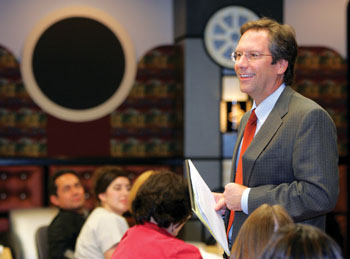
David Posch, Vanderbilt Medical Group CEO, speaks during the American Heart Association’s Heart Walk Team Captain Kickoff Luncheon.
photo by Dana Johnson
Vanderbilt sets $300,000 goal for Heart Walk
Each year more than 10,000 walkers from around the Midstate converge on the Vanderbilt University Medical Center campus to send a message — heart health matters.
The 2005 American Heart Association Heart Walk will be held on Oct. 23. The event, which takes place in more than 500 cities nationwide, has garnered Nashville a bit of recognition.
Vanderbilt's fund-raising levels and participation in the annual walk has increased steadily, which is why it has been ranked among the top three walks nationwide, surpassed only by Seattle and Detroit.
“Your participation is integral to the success and growth of this event,” said Brandi Broome, senior regional director of the American Heart Association. “Your team is the largest by far and the fifth largest in the United States. And the cities that are ahead of you are double your size.
“Team Vanderbilt puts forth an army of volunteer walkers to raise funds, which is so vital,” Broome said during the team captain kick off last week (Aug. 31).
This year Vanderbilt's monetary goal for the walk is $300,000. Last year the team raised $225,000 of the Nashville total of $1.2 million.
Heart Walk funds go to educational and awareness programs and research to help fight heart disease and stroke, and support work being done here by VUMC investigators. Vanderbilt is the second-largest funding recipient of AHA research funds in the country, with 29 awards totaling nearly $4 million.
“Tennessee has one of the worst records for cardiovascular health in the country,” said Joey Barnett, associate professor of Pharmacology, Medicine, Microbiology and Immunology and a board member of the Southeast Affiliate of the American Heart Association.
“There are things we can do to stop this. One million people will die from cardiovascular disease and more women than men will die from it. It is the No. 2 cause of death in children. This is a huge problem that we have to solve,” he told a crowd of more than 100 people.
Barnett said that six years ago there was not much information available about the cause of cardiovascular birth defects in children. Now, scientists are discovering genes, developing treatments and drug therapies to help deal with “one of the major disease killers in the country.”
“Thirty years ago if you were born with some forms of congenital heart disease, there was a one-in-three chance of survival,” Barnett said. “Now we have over 1 million adults who have had successful repairs for congenital heart defects. It’s because of the research.”
Seven-year-old Ellie Moore is an example of how far both research and treatments have come. Born with a transposition of her aorta and pulmonary arteries that limited the amount of oxygen able to mix with her blood, Moore was known as a “blue baby.”
She came before the group to ask for their help in raising money for the AHA.
“Thank you for walking at the Heart Walk with me,” Moore said to a round of applause.
Vanderbilt's team leader for 2005 is David Posch, Vanderbilt Medical Group's chief operating officer. When he spoke he asked several rows of the audience to stand.
“Look around,” he told the audience. “You are looking at friends and colleagues who represent the number of people who will die from cardiovascular disease. One in three people will die from this silent killer.
“We don't think about the magnitude of it, but it is one of the greatest disasters. We don't see it, but it is happening right under our noses.”
Posch encouraged the crowd to motivate their co-workers, neighbors, families and friends to participate in the walk “because we can do better.”













